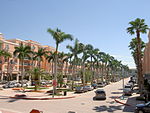House at 1240 Cocoanut Road
Colonial Revival architecture in FloridaHouses completed in 1937Houses in Palm Beach County, FloridaHouses on the National Register of Historic Places in FloridaNational Register of Historic Places in Palm Beach County, Florida ... and 1 more
Palm Beach County, Florida Registered Historic Place stubs

1240 Cocoanut Road (formerly known as the Dickenson House) is a historic house located at 1240 Cocoanut Road in Boca Raton, Florida. It is locally significant for its association with Maurice Fatio, a master architect with an office in Palm Beach.
Excerpt from the Wikipedia article House at 1240 Cocoanut Road (License: CC BY-SA 3.0, Authors, Images).House at 1240 Cocoanut Road
Coconut Road, Boca Raton
Geographical coordinates (GPS) Address Nearby Places Show on map
Geographical coordinates (GPS)
| Latitude | Longitude |
|---|---|
| N 26.333175 ° | E -80.076605555556 ° |
Address
Coconut Road
Coconut Road
33432 Boca Raton
Florida, United States
Open on Google Maps








